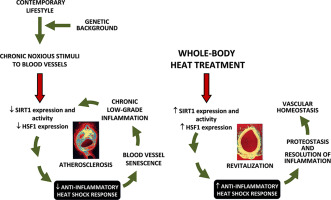Biochimie ( IF 3.3 ) Pub Date : 2018-09-28 , DOI: 10.1016/j.biochi.2018.09.011 Maciel Alencar Bruxel , Angela Maria Vicente Tavares , Luiz Domingues Zavarize Neto , Victor de Souza Borges , Helena Trevisan Schroeder , Patricia Martins Bock , Maria Inês Lavina Rodrigues , Adriane Belló-Klein , Paulo Ivo Homem de Bittencourt

|
Unhealthy lifestyle persistently feeds forward inflammation in metabolic organs thus imposing senescence-associated secretory phenotype (SASP), as observed in obesity and type 2 diabetes. However, SASP blocks physiological resolution of inflammation by suppressing the anti-inflammatory and anti-senescent heat shock (HS) response, i.e., the gene program centered in heat shock factor-1 (HSF1)-dependent expression heat shock proteins (HSPs). As SASP-inducing factors are not removed, leading to the perpetuation of inflammation, we argued that SIRT1-HSF1-HSP axis might also be suppressed in atherosclerosis, which could be reversible by heat treatment (HT), the most powerful HS response trigger. LDLr−/− adult mice were fed on high-fat/high-cholesterol diet from the age of 90 days until the end of study (age of 270 days). After 120 days under atherosclerotic diet, the animals were submitted to either whole-body HT (n = 42; 40 °C) or sham (n = 59; 37 °C) treatment (15 min/session), under anesthesia, once a week, for 8 weeks, being echographically and metabolically monitored. Aortic expressions of SIRT1, HSF1, HSP27, HSP72 and HSP73 were progressively depressed in atherosclerotic animals, as compared to normal (LDLr+/+; n = 25) healthy counterparts, which was paralleled by increased expression of NF-κB-dependent VCAM1 adhesion molecule. Conversely, HT completely reversed suppression of the above HS response proteins, while markedly inhibiting both VCAM1 expression and NF-κB DNA-binding activity. Also, HT dramatically reduced plasma levels of TG, total cholesterol, LDL-cholesterol, oxidative stress, fasting glucose and insulin resistance while rising HDL-cholesterol levels. HT also decreased body weight gain, visceral fat, cellular infiltration and aortic fatty streaks, and heart ventricular congestive hypertrophy, thereby improving aortic blood flow and myocardial performance (Tei) indices. Remarkably, heat-treated mice stopped dying after the third HT session (= 8 human years), suggesting a curative effect. Therefore, evolution of atherosclerosis is associated with suppression of the anti-inflammatory and anti-senescent SIRT1-HSF1-HSP molecular axis, which is refreshed by chronic heat treatment.
中文翻译:

慢性全身热处理可缓解动脉粥样硬化病变,心血管和代谢异常,并延长生存时间,恢复小鼠的抗炎和抗衰老热休克反应
如肥胖症和2型糖尿病患者所观察到的那样,不健康的生活方式会持续地促进新陈代谢器官中的炎症,从而导致衰老相关的分泌表型(SASP)。但是,SASP通过抑制抗炎和抗衰老的热休克(HS)反应(即以热休克因子1(HSF1)依赖性表达的热休克蛋白(HSP)为中心的基因程序)来阻止炎症的生理学解决。由于未消除SASP诱导因子,导致炎症永存,我们认为SIRT1-HSF1-HSP轴在动脉粥样硬化中也可能受到抑制,而热处理(HT)是最有力的HS反应触发因素,可以逆转。LDLr -/-从90天龄到研究结束(年龄为270天),以高脂/高胆固醇饮食喂养成年小鼠。在动脉粥样硬化饮食下120天后 ,在麻醉下,对动物进行全身HT(n = 42; 40°C)或假手术(n = 59; 37°C)治疗(15分钟/节)。连续8周,进行超声和代谢监测。与正常人相比,动脉粥样硬化动物中SIRT1,HSF1,HSP27,HSP72和HSP73的主动脉表达逐渐降低(LDLr + / + ; n = 25)健康对应物,其与NF-κB依赖性VCAM1粘附分子表达的增加平行。相反,HT完全逆转了上述HS反应蛋白的抑制,同时显着抑制了VCAM1表达和NF-κBDNA结合活性。此外,HT显着降低了血浆TG,总胆固醇,LDL-胆固醇,氧化应激,空腹葡萄糖和胰岛素抵抗的血浆水平,同时增加了HDL-胆固醇水平。HT还降低了体重增加,内脏脂肪,细胞浸润和主动脉脂肪条纹以及心室充血肥大,从而改善了主动脉血流量和心肌性能(Tei)指数。值得注意的是,经过热处理的小鼠在第三次HT疗程(= 8人年)后停止死亡,这表明它具有治愈作用。所以,











































 京公网安备 11010802027423号
京公网安备 11010802027423号